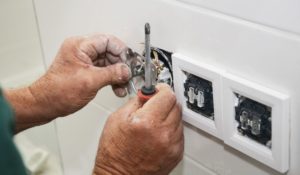Electrical repairs can be intimidating for homeowners, but understanding some of the common issues and how to address them can help you maintain a safe and functional electrical system in your home. In this blog, we’ll explore three common electrical problems and provide guidance on how to tackle them safely.
1. Circuit Breaker Tripping
One of the most frequent electrical issues homeowners face is a circuit breaker that keeps tripping. Circuit breakers are designed to protect your home from electrical overloads, which can lead to fires or damage to your electrical devices. When a circuit breaker trips, it cuts off the power to a specific circuit to prevent such problems.
How to Tackle It:
- Identify the Cause: The first step is to determine what’s causing the circuit breaker to trip. It could be due to overloaded circuits, a short circuit, or a ground fault.
- Unplug or Turn Off Devices: If the circuit breaker trips when you use specific devices, unplug them or turn them off. This will help you identify if the overload is caused by those appliances.
- Reset the Circuit Breaker: After identifying and addressing the issue, reset the tripped circuit breaker. To do this, move the breaker handle firmly to the “off” position and then to the “on” position.
- Redistribute Loads: If overloading is a recurring issue, consider redistributing the electrical loads in your home by plugging devices into different outlets and circuits.
- Consult a Professional: If the problem persists or if you’re unsure about the cause, it’s advisable to consult a licensed electrician. They can conduct a thorough inspection and make any necessary repairs or upgrades to your electrical system.
2. Flickering Lights
Flickering lights can be annoying and indicate an underlying electrical issue. This problem can occur for various reasons, including loose connections, faulty bulbs, or issues with the electrical supply.
How to Tackle It:
- Check the Bulbs: Start by checking if the flickering is limited to a specific light fixture. If so, replace the bulb to see if that resolves the issue.
- Tighten Connections: Loose connections in electrical outlets, switches, or light fixtures can lead to flickering lights. Turn off the power to the affected area and tighten any loose wires or connections. Ensure you follow proper safety procedures, such as turning off the circuit breaker or disconnecting power at the main panel.
- Evaluate Voltage: Voltage fluctuations can cause flickering lights. Contact your utility company to check if there are issues with the electrical supply to your home.
- Upgrade Dimmer Switches: If the flickering is occurring on lights controlled by dimmer switches, consider upgrading to dimmer switches compatible with LED or CFL bulbs. Not all dimmer switches work well with these energy-efficient lighting options.
- Consult a Professional: If you’ve tried the above steps and the problem persists, or if you’re uncomfortable working with electrical components, it’s best to consult an electrician. They can conduct a thorough inspection to identify and fix the underlying issue.
3. Outlets Not Working
Discovering that an electrical outlet is not working can be frustrating, especially if you rely on it for various appliances and devices. There are several potential causes for non-functioning outlets, and knowing how to troubleshoot them can save you time and money.
How to Tackle It:
- Check Nearby Outlets: If one outlet is not working, check other outlets in the same room. Sometimes, a tripped GFCI (Ground Fault Circuit Interrupter) outlet in the circuit can cause nearby outlets to lose power. Reset the GFCI outlet to restore power.
- Test with Different Devices: Test the non-working outlet with different devices to ensure the problem is not with the appliance or device itself.
- Reset Circuit Breakers: Occasionally, a tripped circuit breaker can lead to non-working outlets. Check your circuit breaker panel to see if any breakers need to be reset.
- Inspect for Loose Wires: Turn off the power to the affected outlet at the circuit breaker panel and carefully remove the outlet cover. Inspect the wiring for loose or disconnected wires. If you’re not comfortable doing this, consult a professional electrician.
- Replace the Outlet: If all else fails, you may need to replace the outlet. Turn off the power at the circuit breaker, remove the old outlet, and install a new one following proper wiring techniques and safety precautions.
- Consult a Professional: If you’re unable to identify or resolve the issue, or if you suspect a more significant electrical problem, it’s essential to contact a licensed electrician. They can diagnose the problem and make the necessary repairs.
Remember, electrical repairs can be hazardous if not done correctly. If you ever feel uncertain or uncomfortable working with electrical systems, it’s best to seek professional assistance. Safety should always be a top priority when dealing with electrical issues in your home.





